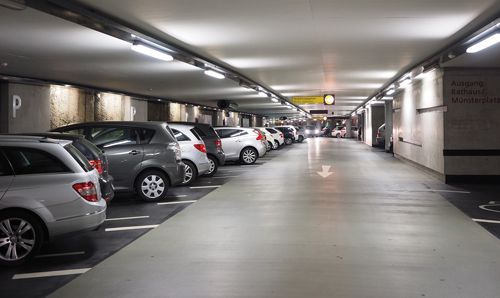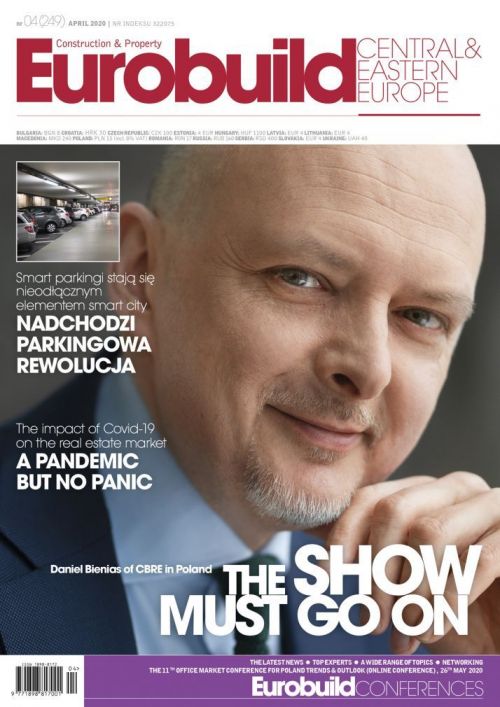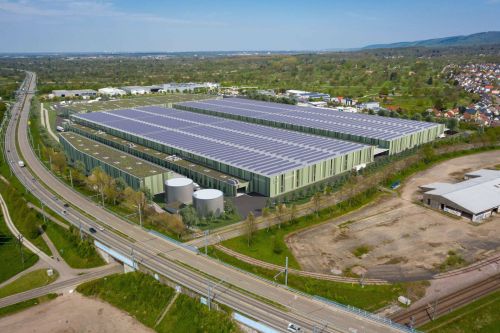The parking space race
New technologies
Paying for a parking space with a smartphone or using a specially designed app to guide you to a free space are now on their way to becoming the rule rather than the exception. In addition, wireless sensors are another of the latest systems that are being introduced to car parks in European cities. These are designed to provide users with information about payments and to record occupancy data, which can then also be used to enable the local authorities to determine the parking rates according to the demand, location and time of day. With this system, drivers are given all the information they need to find the right spaces to park their cars in a given area. The popularity of intelligent parking systems has also been growing in Polish cities. Various systems are being introduced, but most use GPS data from drivers’ smartphones and sensors installed in car parks.
Many systems but the same goal
Comarch’s Smart Parking is one of such systems. One pilot programme (partnered by Energa Oświetlenie) for Smart Parking, which uses video-detection to collate data, is presently underway in Gdańsk. “Our system employs several data recording methods depending on the type of car park, its location, its layout and the type of place. We use cameras and video recording data for this purpose, which are able, among other uses, to recognise not only the status of the parking space but also incorrect parking. It also uses magnetic sensors surface mounted under each parking space. The methods employed are tailored for the specific location. Cameras and video algorithms have a particular advantage in locations where a large number of spaces can be monitored by cameras. Sensors are a good system, but the specific issues related to their assembly and interference with the road infrastructure means that they are not as flexible as cameras, especially if changes are made to the traffic layout in a given area,” explains Wojciech Dec, a product manager at Comarch Smart City.
In his opinion, the system introduced in Gdańsk is a good example of the use of modern technology in a smart city area. Intelligent cameras mounted on streetlights carry out instant video analyses and thus provide data on the number of vacant spaces to the local authorities and residents. “Our system has also been generating interest from smaller towns, as well as the commercial market, including the shopping centre sector,” adds Wojciech Dec. The company is also currently working on the introduction and trial of similar systems outside Poland. “In addition to the free parking space data, cities can also use the system to generate large amounts of traffic statistics and to check the role and impact of a new project on the commuting patterns of the local population,” points out Wojciech Dec.
“We want new systems designed for both residents and tourists, so that they can see whether it’s worth moving their car and where it would be easier to park it,”says Tomasz Wawrzonek, deputy management director of the Road and Greenery Authority in Gdańsk
Best test the water
“We’ve been investing in Intelligent Transport Systems (ITS) for over eight years now. The system, which was introduced with Comarch on ul. Długie Ogrody, supplemented these activities. This pilot scheme has served as a testing ground to a large extent. The data on the degree of space utilisation and rotation has been used in our analyses aimed at increasing the amount of paid parking in the city,” reveals Tomasz Wawrzonek, a deputy director for management on the Road and Greenery Authority in Gdańsk. The city is to introduce systems that use sensors installed for each parking space. In the near future the plan is to upgrade the most important car parks in coastal areas, such as the key car park on the extension of ul. Jana Pawła II, which serves the Jelitkowo and Przymorze districts. “We want new systems for both residents and tourists, so that they can see whether it’s worth moving their car and where it will be easier to park it,” adds Tomasz Wawrzonek. Carrying out a pilot scheme before introducing the entire system certainly has its advantages. “It’s always better to test the water and see what lies under the surface before jumping into the deep-end, other-wise you could have an unpleasant surprise,” advises Tomasz Wawrzonek. According to him, the most also complex task is resolving all the technological issues that arise. Using sensors to measure the occupancy of parking spaces is, as it turns out, not as easy as it looks. “The access to finance for ITS systems is also more tricky than you might think – at the moment it’s difficult to obtain direct European funds for such systems and they are actually only available for such infrastructural projects as the extension of tram lines or similar projects that can be connected to ITS systems,” admits Tomasz Wawrzonek.
According to Paweł Sokołowski of Asseco Data Systems, Rzeszów will be the first city in Poland to use 5G Mesh
Pioneering e-parking in Warsaw
Other Polish cities have opted for a slightly quicker route to ITS, by going straight to announcing tenders for the introduction of comprehensive systems. These include intelligent car parks, charging systems in parking zones as well as the generation of data on the number of free spaces in a given area. Warsaw has been preparing for the introduction of such a system for some time. “Six companies have begun talks with the city to clarify all the key issues related to the future system, which is why we have yet to announce the exact date, location or number of spaces that will be covered by the system. The introduction of the scheme has only been made possible through the employment of EU funds from the Virtual Warsaw Functional Area programme,” explains Mikołaj Pieńkos, the head of the social communication department of the Municipal Roads Authority in Warsaw. The e-parking system in the city will eventually be one of the most modern in Europe. It will include around 30,000 parking spaces and use a map of free spaces in the city’s unguarded paid parking zone [SPPN]. Sensors or cameras are to provide live updates of which space have cars parked on them. Drivers using the mobile app will quickly be able to find the best route to their eventual space and then pay for their parking.
Warsaw’s Municipal Roads Authority insists that the introduction of the new system will bring with it many benefits. Drivers will save time and fuel (up to as much PLN 1,500 per year). Emissions of carbon dioxide and other harmful substances should also decrease. The traffic situation in the centre of the capital city will also improve. Currently, cars circling in search of parking spaces make up 20–30 pct of the traffic in the city centre. Over time boroughs outside the city, such as Legionowo, Marki, Pruszków, Radzymin and Ząbki, are to be included in the system. Warsaw has already obtained an EU subsidy of PLN 17 mln for the launch and operation of the system in 2020–2026. However, the implementation of such a large and pioneering project requires time and a great deal of preparation. In order for the system to cover, for instance, a paid parking zone, it’s necessary to map all the streets and fit monitoring devices along them. Updating the data will also be a challenge. The timeframe for the introduction of the project, including the design and preparation of the system, its databases as well as the purchase and assembly of equipment for the entire zone, has been initially estimated at around 24 months. “When the consultative talks are completed, the contractors will be invited to submit their bids and it will then be possible to select a contractor. However, I cannot provide specific dates for any of this at the moment,” adds Mikołaj Pieńkos.
Smart city in the southeast
Rzeszów, in the southeast of Poland, might be about to steal a march on Warsaw in terms of ITS systems. An intelligent parking system is to be launched in Rzeszów as early as 2021. The PLN 14.7 mln project is being implemented by Asseco Data Systems and is designed to streamline the traffic in the paid parking zone and reduce the time needed to find a free parking space. Cameras, sensors and neural networks are to be installed in the area of streets covered by the zone to generate and analyse data around the clock. Information about vacant spaces is to be transferred to interactive information boards in the paid parking zone and via a mobile app available to residents. It will also be integrated with external software for processing the parking fees. According to Asseco, this system has so far only been introduced in a few European cities. “This is a unique smart city project. Apart from the metering and monitoring system, we will also be installing a data transmission system, which will act as a relay between the supervision centre and every other part of the system. We will also be upgrading the data processing centre. Importantly, a fibre optic network is to be laid throughout the city centre, using the existing LMDS and Mesh network to connect the system with other buildings and structures in the city in the future. Rzeszów will thus be the first city in Poland to embrace 5G Mesh,” claims Paweł Sokołowski, the director of smart city development at Asseco Data Systems.
Comprehensively in Katowice
Katowice is also turning its attention to the latest parking systems, having recently announced a tender for an Intelligent Control System. A total of PLN 60 mln has been allocated for the system, which involves the use of a mobile app for getting around the city. And it is designed to cover the entire city, not just its centre or selected districts. The system will also feature electronic advertising hoardings informing drivers in real time about traffic incidents or diversions. There will also be more cameras for reading the licence plates of passing cars. All the data will ‘flow’ to the traffic management centre. With the app you will be able to use your smartphone to check on the state of the traffic, the parking space occupancy, recommended detours, the ease of transit along routes as well as for generating a travel plan. The system will also notify drivers of traffic accidents and traffic light failures as well as demonstrations and other large scale events, while giving weather updates and directions on how to get to the nearest petrol or service station. However, it is not yet clear when the system will be introduced. “The three bids submitted in the tender are currently being analysed. They have all exceeded the budget set for the project and so a final decision is yet to be made,” reveals Agnieszka Sitko of the transport department of Katowice city council. The companies taking part in the tender include Siemens Mobility, Sprint and Spanish consortium Aldesa Construcciones and Aeronaval Construcciones (which priced their bid at PLN 82 mln).
“Our system has also been generating interest from smaller towns, as well as the commercial market, including the shopping centre sector,” adds Wojciech Dec of Comarch
Access control in a smart city
According to Tomasz Wawrzonka, the intelligent systems that are being installed for parking increasingly tend to feature access control, that is, the controlled entry to specific zones in cities. “We are currently preparing automated systems for identifying vehicles entering specific areas of the city that can only be accessed via special identifiers. For the moment, the only way to control such zones is by state and municipal police stopping or checking vehicles, which itself can cause congestion. We want this to be done automatically, for example, by using barriers that prevent entry if the system does not recognise the vehicle’s entitlements; but if it does, the barrier is removed, thus allowing the vehicle to enter the zone. Such systems also operate in other cities and so we are not pioneers in this respect. They use licence plate recognition systems. We are wondering whether to opt for a kind of hybrid – a combination of a licence plate recognition and a radio identification system,” explains Tomasz Wawrzonek.
Intelligent parking systems can also come with other functions, depending on what might be required. In Piaseczno just south of Warsaw, the intelligent parking system there has ten additional ultrasonic sensors for checking how full the litter bins are as well as six flood alarm sensors for monitoring the water level in rivers and drainage ditches. A range of sensors for monitoring the natural environment (the temperature, noise level and air humidity) have also been installed. “With this new technology and the Internet of Things, our district can become friendlier for its residents, better organised and more efficient at using resources,” insists Daniel Putkiewicz, the mayor of Piaseczno town and borough. This extensive system has been developed by Emitel and involves the use of 130 sensors for determining the parking space occupancy in the town.
Krzysztof Witoń
product manager at ITS Siemens Mobility
For the city and the small town
In city centres, road users looking for parking spaces make up about 40 pct of the overall traffic. In response to such challenges faced by cities, Siemens Mobility has a developed system for the effective management of spaces in outdoor and indoor car parks – the Sitraffic Guide. This system centralises the monitoring and management of parking spaces in the city by guiding traffic users with the use of information services and parking signs. Users can access the current data on the parking situation via the city’s web portal or a modern navigation system. These systems can be used in both small towns and larger urban centres. They have already been successfully put into operation in several cities across Germany – including Freiburg, Wuppertal, Stuttgart and Karlsruhe – and in Bern and Lugano in Switzerland as well as Luxembourg. Some elements of this system have also been introduced in Poznań. Mobility-based parking systems are developing rapidly. These include real-time data exchange between intelligent infrastructure and vehicles using, for instance, ITS-G5 radio networks and 5G mobile networks. Such systems have been launched in the UK and Austria.





















































